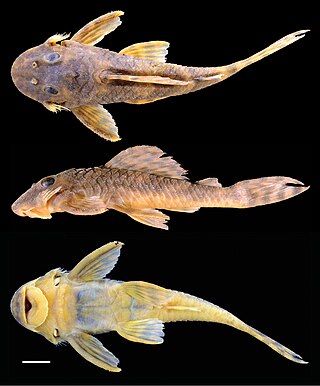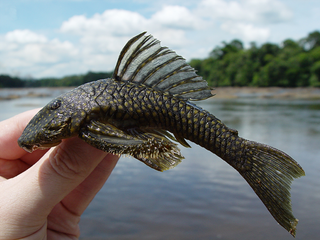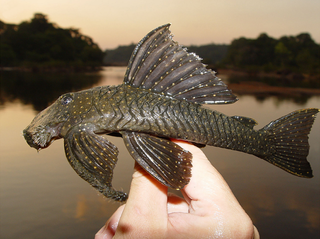
Peckoltia sabaji is a species of catfish in the family Loricariidae. It is native to South America, where it occurs in the basins of the Rupununi, the Essequibo River, and the Takutu River in Guyana, as well as the basins of the Casiquiare canal, the Rio Negro, the Cinaruco River, and the Orinoco in Venezuela. It is usually found among boulders in medium to large rivers. The species reaches 19.8 cm SL and is of disputed classification.

Peckoltia vittata is a species of catfish belonging to the subfamily Hypostominae of the family Loricariidae.
Ancistrus macrophthalmus is a species of catfish in the family Loricariidae. It is native to South America, specifically found in the Orinoco River and its lower tributaries in Venezuela. The species reaches 7.9 cm (3.1 in) SL. It is occasionally seen in the aquarium trade, where it is one of multiple species sometimes referred to as "medusa plecos".
Ancistrus ranunculus is a species of catfish in the family Loricariidae. It is native to South America, where it occurs in the basins of the Xingu River, Trombetas River and the Tocantins River in Brazil. It inhabits areas with clear water and without strong currents, and it is known to inhabit narrow cracks in submerged rocks, small passages, and spaces below flat rocks. The species is large for a member of Ancistrus, reaching 19.5 cm in total length. It sometimes appears in the aquarium trade, where it is one of several species known as a medusa pleco, although it may be referred to by its L-number, L034.

Ancistrus multispinis is a species of catfish in the family Loricariidae. It is native to South America, where it occurs in the Atlantic coastal drainage of eastern Brazil, ranging from the Macacu River to the Maquiné River. The species reaches 14.2 cm (5.6 in) SL. The species has nocturnal habits and has been used in studies on the impacts of deltamethrin on fish blood in Brazil.
Peckoltia braueri is a species of catfish in the family Loricariidae. It is native to South America, where it occurs in the basins of the Rio Negro and the Branco River. It is typically found among large boulders in fast-moving riffles. The species reaches 10.3 cm SL.

Peckoltia compta is a species of catfish in the family Loricariidae. It is native to South America, where it occurs in the Tapajós basin in Brazil. The species reaches 6.2 cm SL. It was described in 2010 by Renildo Ribeiro de Oliveira and Jansen Zuanon, Lúcia Rapp Py-Daniel, and Marcelo Salles Rocha primarily on the basis of coloration and patterning. Its specific epithet, compta, is stated to be derived from the Latin word for "adorned" or "ornamented", referring to the species' distinctive color pattern.

Peckoltia ephippiata is a species of catfish in the family Loricariidae. It is a freshwater fish native to South America, where it is known from the Leitão River, which is part of the Madeira River drainage in the state of Rôndonia in Brazil. The species reaches 10.2 cm SL.

Peckoltia lujani is a species of catfish in the family Loricariidae. It is native to South America, where it occurs in the Orinoco and Meta River basins in Venezuela and Colombia. The species reaches 7.5 cm SL.
Peckoltia oligospila is a species of catfish in the family Loricariidae. It is a freshwater fish native to South America, where it occurs in the lower Amazon River basin in Brazil. The species reaches 10.5 cm SL. It appears in the aquarium trade, where it is typically referred to either by its associated L-number, which is L-006, or as the brown-dot peckoltia.
Peckoltia simulata is a species of catfish in the family Loricariidae. It is native to South America, where it occurs in the Oyapock River in French Guiana. The species is typically found in small forested creeks with a substrate of gravel or sand, as well as rocks, leaves, and wood. It has been collected alongside a variety of other species, including other loricariids belonging to the genera Ancistrus, Farlowella, Guyanancistrus, Otocinclus, and Rineloricaria.
'Pseudancistrus' megacephalus is a species of catfish in the family Loricariidae. It is of uncertain and disputed classification.
Spectracanthicus zuanoni is a species of catfish in the family Loricariidae. It is native to South America, where it occurs in the Xingu River basin in the state of Pará in Brazil. It is usually found in areas up to 2 m deep with strong currents and rocky substrates, where it is often seen hiding beneath rocks. It is known to occur individually or in groups of three, with juveniles being found alongside other loricariid species, such as Ancistrus ranunculus, Baryancistrus xanthellus, Hopliancistrus tricornis, Parancistrus nudiventris, Peckoltia vittata, and its congener Spectracanthicus punctatissimus.
Hypostomus salgadae is a disputed species of catfish in the family Loricariidae that may be synonymous with the species Hypostomus carvalhoi. It is native to South America, where it occurs in the Jaguaribe River basin in Brazil. FishBase reports the maximum length of the species as 2 cm in standard length, but it is likely that the species can exceed this size. It is believed to be a facultative or obligate air-breather.
Ancistomus feldbergae is a species of catfish in the family Loricariidae. It is native to South America, where it occurs in the Xingu River basin in Brazil.
Ancistomus micrommatos is a species of catfish in the family Loricariidae. It is a freshwater fish native to South America, where it is known only from the Tocantins River basin in Brazil. The species reaches 11.9 cm in standard length. Although originally described as a species of Hemiancistrus in 2003, a 2015 review conducted by Jonathan W. Armbruster, David C. Werneke, and Milton Tan listed the species as valid within Ancistomus. The same review also reported that no characteristics were found to separate A. micrommatos from its congeners A. spilomma and A. spinosissimus, indicating that the three may actually all be the same species.
Ancistomus spinosissimus is a species of catfish in the family Loricariidae. It is a freshwater fish native to South America, where it is known only from the upper and middle Tocantins River basin in Brazil. The species reaches 12.7 cm in standard length. Although originally described as a species of Hemiancistrus in 2003, a 2015 review conducted by Jonathan W. Armbruster, David C. Werneke, and Milton Tan listed the species as valid within Ancistomus. The same review also reported that no characteristics were found to separate A. spinosissimus from its congeners A. micrommatos and A. spilomma, indicating that the three may actually all be the same species.
Ancistomus snethlageae is a species of catfish in the family Loricariidae. It is native to South America, where it occurs in the Tapajós basin in Brazil. The species reaches 22 cm in total length. Although originally described as a species of Ancistrus in 1911 by Franz Steindachner and subsequently reclassified in the genera Hemiancistrus, Lasiancistrus, and Peckoltia, a 2015 review conducted by Jonathan W. Armbruster, David C. Werneke, and Milton Tan listed the species as valid within Ancistomus.

Guyanancistrus longispinis is a species of catfish in the family Loricariidae that is of disputed classification. It is native to South America, where it occurs in the Oyapock basin in French Guiana. It is typically seen in shallow rapids with rocky substrates and moderate levels of illumination. It is known to occur alongside the species Guyanancistrus brevispinis, Harttia fowleri, and Crenicichla ternetzi, as well as members of the genus Ancistrus. The species reaches 10.4 cm in standard length and may be a facultative air-breather.

Guyanancistrus niger is a species of catfish in the family Loricariidae that is of disputed classification. It is native to South America, where it occurs in the Oyapock basin in French Guiana. Though reportedly uncommon, it is typically seen in rapids where the species Pseudancistrus barbatus is also present, although the ecological relationship between the two is not known. The species reaches 15.9 cm in standard length, although it has been reported to reach 25.4 cm, and it may be a facultative air-breather.









